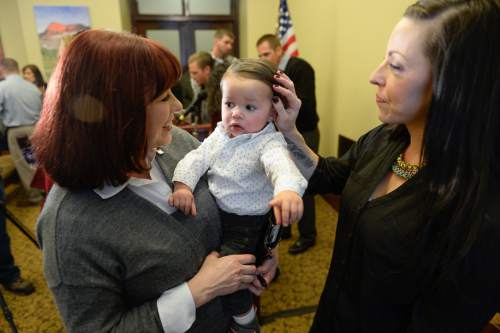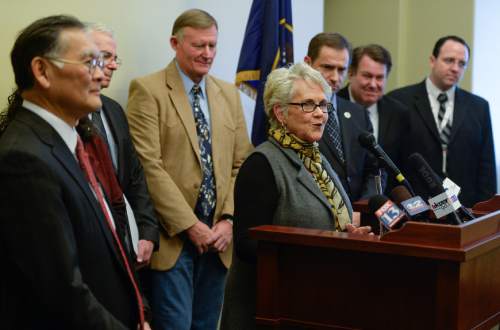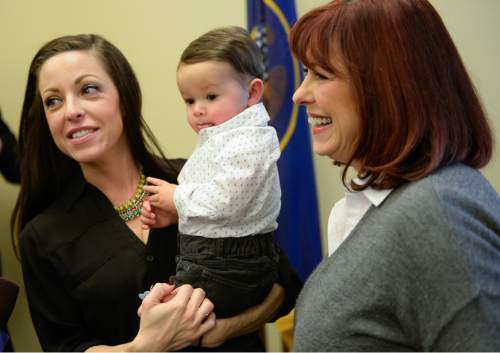This is an archived article that was published on sltrib.com in 2016, and information in the article may be outdated. It is provided only for personal research purposes and may not be reprinted.
Erin Finkbiner avoided the emotional toll of her father's suicide by faking the physical pain associated with her autoimmune disease.
A doctor prescribed Percocet before she turned to OxyContin and finally overdosed on heroin seven years ago.
"It was a perfect recipe for disaster" — but not death, the 32-year-old mother said, because she was given medication that reversed her overdose.
Hundreds of Utahns have not been so lucky. In 2014, prescription drugs were the cause of 358 deaths in the state, according to preliminary numbers from the Utah Department of Health (UDOH). That's a slight increase from 354 in 2013, and the highest annual number of such deaths ever recorded in Utah.
A bipartisan group of lawmakers and the head of the UDOH hope a batch of legislative proposals will help more Utahns survive — or avoid — addiction. They announced a collection of legislative proposals in a Friday news conference to highlight the need for more public funding to equip first responders and others with the anti-overdose drug naloxone.
"It's unfortunate that not enough doctors know about it. We need PSAs," said Rep. Carol Spackman Moss, who proposes that the Legislature declare the state's opioid overdose problem a medical emergency."It's an epidemic."
The Holladay Democrat has a bill clarifying that medical providers can provide the reversal drug and directions on how to use it without fear of prosecution. Another Republican measure would strengthen tracking of prescriptions for the powerful painkillers between doctors and pharmacies, making it more difficult for a patient to acquire multiple prescriptions from different doctors.
Overdoses claimed the lives of 326 Utahns in 2007, a high for the state at the time. The rate of overdoses fell by 28 percent between then and 2010 amid a statewide campaign warning of the effects of painkiller addiction, UDOH Director Joseph Miner said Friday.
But since legislative funding for the prevention effort expired in 2010, he said, the number of deaths has climbed.
Republican Reps. Mike McKell, of Spanish Fork, and Steve Eliason, of Sandy, want the state to get the word out again. They propose two measures to build on a 2014 Utah law allowing concerned family members, friends and others to legally obtain naloxone.
Doctors would be able to write a standing prescription for the anti-overdose agent under Eliason's proposal, instead of just a one-time allowance. He also wants people in needle-exchange programs to equip users with information on naloxone. And McKell wants $1 million in public money to fund an outreach program housed at the Utah Department of Health.
The number of prescription drug overdoses historically has been higher than deaths from all other kinds of drugs, including heroin and cocaine. Most deaths have been ruled accidental, with the three top drugs oxycodone, methadone and hydrocodone.
For a handful of families at the Capitol on Friday, naloxone was too new to save children and siblings lost to overdoses.
Sandra Kresser's 25-year-old son overdosed on heroin. The addiction, Kresser said, stemmed from a prescription for methadone for two herniated disks three years earlier.
"We've got this massive devastation," she said, "because of drugs that are like heroin in pill form."
Moss, a former Olympus High School teacher, also said she has lost a stepson and several former students to drug overdoses.
Providers would not be off the hook this year at the Legislature. A second proposal from McKell aims to strengthen tracking of prescriptions and overdoses, allowing physicians and pharmacists to access the database.
Jennifer Plumb, a pediatrician at Primary Children's Hospital, leads an initiative that has distributed more than 12,000 "naloxone kits" containing vials of the substance. The free packages contain syringes and brochures on how to administer the medication. Plumb knows of 20 instances of overdoses being reversed, she told reporters and families Friday.
Plumb rejects the notion that the drug is simply one way for addicts to continue abusing drugs.
"It's not," she said, adding that family members who obtain the kits are sending a message to loved ones with addiction that they are valued.
Without programs such as Plumb's, naloxone injection kits costs about $50. A nasal spray can cost $80 to $120, said Chris Stock, a pharmacist in Salt Lake City, with insurance typically covering the cost, Stock said.
"Utah Medicaid," he said, "has promised they'll cover it."
But the reach of the program is in question as Utah lawmakers still struggle to agree on a plan to expand health insurance for low-income Utahns.
Nationally, drug overdose deaths are climbing. In 2014, more than 47,000 people died, a 137 percent increase in the number of deaths from opioid painkillers and heroin from 2000, according to the Centers for Disease Control. Utah's rate was seventh, behind neighboring New Mexico, No. 2. West Virginia was highest.
Twitter: @anniebknox









